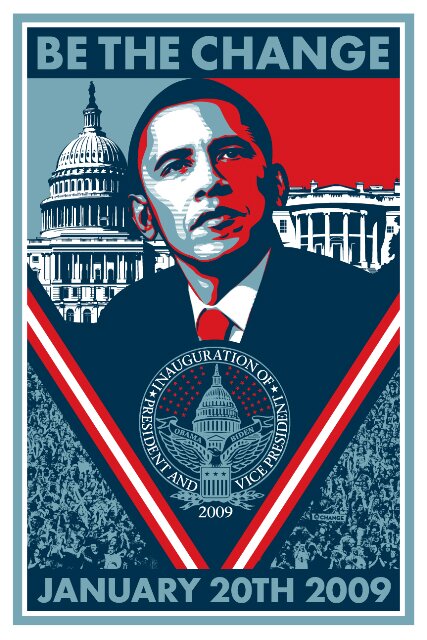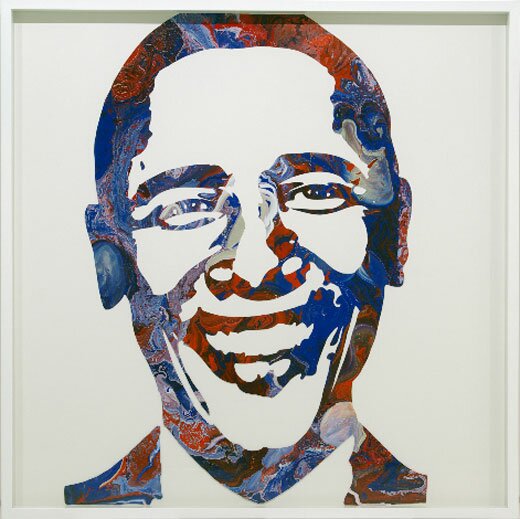politics
Archived Posts from this Category
Archived Posts from this Category
Posted by ben on 20 Aug 2009 | Tagged as: design, politics
Lucky Jim, a London squatter with a great blog, scores some old anti-colonialist posters at one of his squats. I’m particularly fond of the ANC posters:

African National Congress poster
Posted by ben on 16 Jun 2009 | Tagged as: graffiti, politics
FryingPanFire posts images of street art from Tehran, made by pro-Mousavi activists (h/t Andrew Sullivan). This creature holds a green sign, like many of the protesters:

Posted by ben on 25 Mar 2009 | Tagged as: arts organizations, politics
The New York Times has a good overview of changes in arts policy and funding in the new Obama administration. This is the first I’d heard of the new White House arts adviser position, which seems similar to an idea Tyler Green proposed just after the inauguration. The arts adviser may have a bit less scope than Green envisioned, however. From the Times:
Mr. Ivey, who led the transition team devoted to the arts and recently met with Mr. Dale, said he expected the White House position to involve coordinating the work of the [National Endowment for the Arts], the National Endowment for the Humanities, and the Institute of Museum and Library Services.
Now here’s just one paragraph from Green’s intelligent discussion of the arts adviser he hoped for:
For example, in the wake of the No Child Left Behind law, arts education in America’s public schools has become a federal issue. There are internationally important arts treasures on government land, including Robert Smithson’s Spiral Jetty in Utah and Mount Rushmore, in South Dakota. Both face conservation issues. American museum directors increasingly run into thorny diplomatic issues while negotiating the potential return of antiquities to their countries of origin, but they have no place in the federal government with which to consult even though there are diplomatic implications to their decisions.
This would take someone with quite a bit more authority than just coordinating NEA, NEH, and IMLS. But we can hope that with time this adviser could become responsible for helping non-arts-specific agencies such as the Dept of Education, Pentagon and the National Park Service deal with tricky art-related issues that fall into their laps.
Much of the rest of the article deals with funding, pointing out that although Obama and the Democrats found $50 million for the NEA in the stimulus bill, and another $10 million in the omnibus spending bill, its funding is still lower than it was in 1992 (when it received $172 million).
There’s also the issue of not having appointed a chairman to the NEA, but this is a problem that is hardly specific to that agency; the Obama administration has been plagued with empty desks throughout numerous agencies, most troublingly the Treasury.
One thing not mentioned in the article is the immense quantity of bad art Obama is inspiring.
Posted by thomas-cummins on 12 Feb 2009 | Tagged as: politics, responses/reviews, video/film
It’s Oscar time. Just saw the award-winning film “The Reader” and was pleasantly surprised by how good this movie actually is. It’s about inherited guilt of the Holocaust, interpersonal relationships, and as the screenwriter so eloquently put it – “It’s about literature as a powerful means of communication, and at other times as a substitute for communication.” The movie garnered 5 Oscar nominations (including Best Picture) and Kate Winslet is definitely deserving of her front-runner status as Best Actress in her portrayal of an S S guard who seduces a teenage boy.
It’s this portayal, though, that some criticize as being unsympathetic to the Holocaust. The film is immersed in German philosophy and it’s hard for me not to draw references to Hannah Arendt – a German Jew who similarly had an affair with an older Nazi in the form of her teacher Martin Heidegger. In Arendt’s own book on Adolf Eichmann, she coined the term “the banality of evil” when she frighteningly observed how ‘normal’ most Nazis actually were and the need to conform to the social environment, no matter how wrong it might be, is one of the most defining aspects of the human condition. This phenomenon has been shown again and again in subsequent cases like the Stanford prison experiment, the Milgram experiment, the Hofling hospital experiment, the Asch conformity experiments, The Third Wave, Abu Ghraib Prison, as well as in cults everywhere. It’s impossible for a person to step out of their Zeitgeist no matter how hard they try and, indeed, this is the ultimate struggle in the individual (and artist) – between authenticity to him/her own self versus placing him/herself within the social norms of the time.
It’s too easy, though, to sweep Holocaust horrors under the rug by Otherizing historical figures of the past and we need to look at ourselves to find the common denominator in genocide which pervades our history but which still continues to this day. It’s time to stop finger-pointing and go beyond simplistic terms like good and evil. This, however, doesn’t excuse Holocaust deniers in the news today like Bishop Richard Williamson but shows, rather, how very real genocide is. I’m always stunned by how beautiful Hitler’s art actually was and am compelled to refer back to the interesting film ‘Max‘ which poses the question – What would of happened if Hitler’s early career as an artist was accepted by his society?
.
Posted by ben on 25 Jan 2009 | Tagged as: arts organizations, politics
Since Obama took office, I’ve seen a number of people call for the creation of a cabinet level Secretary of Arts (or Secretary of Culture), through op-eds, online petitions, and other channels. These proposals have left me cold for a few reasons. Most of the advocates of this measure frame it as a generic plea for the government to do more to support the arts. But why can’t congress just increase funding for the numerous federally controlled arts organizations that already exist? William Ferris also points out that the several existing arts-related government organizations (NEH, NEA, PBS, Library of Congress, Smithsonian, etc) sometimes have turf wars, and could benefit from some cabinet-level coordination and delineation of roles. Ok, but what is the nature of these conflicts, and could they be solved in another way?
I’ve not yet seen a really compelling argument for the Secretary of Arts position, which would, it must be admitted, seem rather frivolous to most Americans when the incoming administration has so many huge issues to deal with. A few days ago Tyler Green at Modern Art Notes proposed what seems like a much more practical move: appointing a White House arts adviser. Green takes as his model the White House science adviser, who deals with numerous agencies in coordinating a cohesive science policy. The White House arts adviser could play a similar role: advising the Department of Education on arts curriculum, the Pentagon on how to approach cultural monuments and institutions in occupied countries (remember the Iraq museum debacle?), the State Department on granting visas to visiting artists, etc. Apart from advising federal agencies, this arts advisor could help museums deal with the thorny issue of returning foreign artifacts to their home countries, and other non-federal matters that nonetheless have dimplomatic repercussions. Green discusses all these issues and more in laying out a pretty convincing case for this new appointment. Check it out.
Posted by aaron on 20 Jan 2009 | Tagged as: celebrations, image & sound, music, politics
Performed by Los Dorados del Norte. Music & lyrics by… ?
Posted by ben on 19 Jan 2009 | Tagged as: poetry, politics, public art
Jim Fisher, discussing the challenges Elizabeth Alexander faces in writing an occasional poem for the inauguration, explains why this kind of poetry doesn’t usually work:
Why is poetry so different from other disciplines? Music and the plastic arts (painting, sculpture, architecture) are demonstrably receptive to commissions, with great works created on command, as it were. With sculptures and buildings, we only have to walk a few downtown blocks in most major cities to see lasting examples of both, pro and con.
The problem for poets is not the commission — Milton’s “Lycidas” and Marvell’s “Upon Appleton House” are both immortal poetry commissions — but the occasion, which fixes the poem with a public event. Once the function has passed, the poem loses the immediacy of its audience, and with it the power to summon meaning and emotion over time.
So let’s dispense with this idea that poets can produce lasting poems for public events. It’s unfair to the audience, discomposes the poet, and probably confirms the low opinion of poetry some listeners already hold.
When we read poetry to ourselves, the occasion of a great poem is an internal event, organizing the perceptions and determining the material. When that occasion is a point in time and place, the work is more likely to be stuck there when published: partial, responsible, contemporary, rarely timeless.
[hat tip]
Posted by thomas-cummins on 18 Jan 2009 | Tagged as: interviews, politics, public art
Inauguration weekend is underway. Kurt Andersen investigates ‘Artists and Obama‘ at Studio360.org. You can find the following interviews there for your listening pleasure:
Shepard Fairey, designer of the iconic red-white-and-blue Barack, and other Obama portraitists admit to riding the Obama wave but fear they might have over-hyped the president-elect to unrealistic expectations.
The departing chairman of the National Endowment for the Arts, Dana Gioia, was a Bush appointee but he’s down with a Democrat who reads poetry.
Sculptor Richard Serra asks Obama for a Culture Minister as well as for a grassroots art movement.

Posted by ben on 16 Jan 2009 | Tagged as: intellectual property, politics, video/film
Nate Anderson at Ars Technica covers what is probably the best cause célèbre I’ve seen for oponents of restrictive copyright enforcement. The article recounts the case of Kevin Lee, a prolific film blogger who used YouTube extensively to publish “video essays” which interspersed his own critical insights with short film clips. Lee’s work demonstrates everything that’s good and noble about the Internet: an unpaid blogger pioneering new avenues of critical discourse, just to share his love of cinema with others. His blog, Shooting Down Pictures, reveals a passionate, intelligent observer documenting his travels through the greatest 1,000 films. Read more about the significance of Lee’s work at The House Next Door.
But all this came to a grinding halt when, after a third DMCA takedown notice was served against Lee, over five hours of his critical commentary was deleted by YouTube and his account closed. I’ve written about what I see as some helpful innovations on YouTube’s part in dealing with copyright, but this “three strikes” rule is absurd on its face. YouTube offers some fair objections to the idea that it should manually review all of these takedown notices, but deleting whole user accounts due to a small ammount of allegedly infringing content is bad for YouTube, bad for free speech, and will ultimately feed the backlash against copyright in general. It’s not even clear that the video that triggered the account deletion was violating copyright; Lee has a strong case that his critical videos fall under fair use protections.
The blame for this doesn’t fall entirely on YouTube, as many of the large rights holders are taking a “shoot first, ask questions later” stance with takedown notices, and of course the DMCA itself encourages this behavior. Any lasting solution will involve a combination of legal reform and consumers creating a shitstorm whenever something like this happens.
[Cross-posted at Scattered Work]
Posted by ben on 10 Nov 2008 | Tagged as: arts organizations, politics, silliness
George W. Bush: “Lame duck, huh? I’ll show you what a lame duck can do!”
Posted by ben on 13 Aug 2008 | Tagged as: politics, public art, responses/reviews, video/film

There’s been some grumbling lately about the “fake fireworks” at the Olympics in Beijing. Here’s how the story goes: the people responsible for planning the fireworks developed a display that would outline 29 footprints in fireworks from Tiananmen Square to the Bird’s Nest stadium. Due to the grandiose nature of this display, no single person would be able to see it all — not even from a helicopter. So the special effects team spent a year developing a CGI version of the footprints, made to look as if a helicopter were flying along the route filming it live (including a shaky camera and digitally generated Beijing smog). This video was inserted into the “live” broadcast stream sent to TV networks worldwide, and shown within the stadium itself. No disclaimer was ammended to the video, so audiences thought they were watching “actual” fireworks. When the truth was revealed, many viewers became upset at the deception.
There are so many implications to this I don’t think I can really unpack it all here, but I’ll give it a try. To begin with, we have the notion of authenticity. This July article from the New York Times helps explain the the gap between Chinese and Western relationships with authenticity. (Most of the relevant discussion comes on the last page of the article, e.g.: “it is common practice [to] substitute copies of famous works of art in museums when the originals are unavailable.”) The fireworks actually happened, but to give an impression of the true scope of the display, some cinematic sleight-of-hand was necessary. Here’s a video someone shot of the — not so impressive. The idea here was not to embellish reality, but to give viewers some sense of a reality they couldn’t fully experience. A disclaimer would in some sense rob viewers of the experience as well: perhaps ironically, the closest a viewer could get to experiencing the full display was to watch a CGI version of it thinking it was authentic. But, for a Westerner, that won’t do. If our experience of a thing must be partial in order for it to be real, so be it, even if that “reality” is only through the TV screen. We’d rather watch a video of part of the display, and then read about how it stretched across Beijing, than to see a simulation of the whole thing.
I’m sure it would be possible to go on for a few thousand more words on the ideas of authenticity that this brings to the fore (sprinkling in some appropriate snippets of Baudrillard, of course), but let’s move on. What was the point of this display? In the West, Tiananmen Square is largely associated with the Tiananmen Square Massacre, but its history is a comprised of a long string of political and military conflicts. Symbolically, it can be seen as the seat of political power in China, stretching back to the Ming Dynasty. These footprints, walking from the site of battles, protests, massacres, and Mao Zedong’s proclamation of the People’s Republic of China in 1949, to the site of the Olympics, represent China’s lurching entry into the capitalist global economy.
China is stuck in a precarious position with the West: it constantly signals that it wants to engage as political equal with the US and the EU, but cannot bring itself to uphold even the inconsistently enforced standards of human rights cherished by the West. As noted in the Sky News article linked above, the architect who designed the Bird’s Nest stadium recently wrote on his blog about the Beijing Olympics:
He was directly critical of China’s ruling communist party, characterising the ceremony as “a showcase of the reincarnation of the Marxist imperialism; the ultimate paragon of an all embracing culture of fascist totalitarianism; an encyclopaedia that encompasses total defeat in intellectual spirit.”
Perhaps the Chinese relationship with authenticity is indicative of a deeper disconnect between the Chinese and Western understanding of the world. Even in its symbolization of a movement towards Western values, China has managed to offend.
UPDATE: Oh yeah, and then there’s this.
Posted by ben on 09 Aug 2008 | Tagged as: books, politics
The Orwell Prize publishes George Orwell’s diaries in blog format starting today with the entry from August 9, 1938. [hat tip]
Posted by ben on 26 Jul 2008 | Tagged as: graffiti, in yo face, outsider, poetry, politics, public art
I’ve noticed this one for months (years?) on the access road to I-10:

Also, a followup on Justin’s great street art find from a couple months ago. Apparently this is by the same artist (it’s in the men’s bathroom at the Voodoo Lounge, aka SWC Club):

Posted by ben on 02 Jul 2008 | Tagged as: essays, performance art, politics, renegade performances, responses/reviews
My admittedly slow-on-the-draw take on the Aliza Shvarts controversy was just published in the Current:
Art can be viewed as a sort of safe space in which society allows itself to push moral boundaries with the understanding that the artist is asking a question. Behavior that would otherwise be proscribed is permitted in order to catalyze moral evolution. We can draw analogies here to other safe spaces that humans set up in order to take otherwise unacceptable risks: the boxing ring, the therapist’s office, even the dreamworld, where desires and fears are explored without physical commitment. Therapeutic uses of art are well established, as is the connection between dreams and artistic production.
Problems arise, however, when the boundary between art and life is blurred. When we move from image to enactment, a crucial line has been crossed, and the artistic space becomes not so safe. As much as morally questionable performances have been integrated into the artistic canon, it is possible that they will always provoke trepidation, if not outrage, in the general public.
Further reading:
Posted by ben on 01 Jul 2008 | Tagged as: acquisitions, adventure day, arts organizations, design, photography, politics, public art
It was closing time at my neighborhood bar, the three of us leaning on a concrete table surrounded by cactus, when I heard about the dumpster full of art. A large scale public mural by Anton Vidokle was in the process of being removed by a company which had bought the building. The mural, an application of 100 vinyl decals on metal panels, depicted simplified versions of logos from bankrupt companies. Now the panels were being removed and thrown in a dumpster in the parking lot next to the building.

Installation shot of 100 Bankrupt Corporations (public geometry) by Anton Vidokle (courtesy Artpace)
We finished our beers, jumped in the car, and headed downtown. When we found the dumpster at around one in the morning, we realized immediately that we weren’t the first San Antonio art scenesters to have this idea. While almost all of the panels had been removed from the building, only a dozen or so were left in the dumpster. We jumped in and started throwing our favorites out into the parking lot. After cramming as many as we could into the trunk of the car, we took off, leaving a few for any other art scavengers who might not look down their noses on dumpster diving. After installing a panel with red semi-circular fragments of anonymous logos in my living room, I started noticing the other pieces around San Antonio. Stacked up near studios, hanging on workshop walls, leaning up against houses, they spoke of something just out of reach. Over the course of their lives, from symbols of production and commerce which drowned in a sea of such symbols, to their resurrection as material for an intricate yet minimal public mural, and finally to their cold, arbitrary fragmentation along the lines of a surface grid, they moved from abstraction to abstraction, carrying bits of identity from place to place.


Photos of Vidokle panels in the wild by Justin Parr
 For a long time I waited for the few remaining panels along the top and down one side of the building to be removed. Every time I drove down San Pedro I looked to see if a few more of these public geometries had been taken from the face of the building, if perhaps the dumpster might have a few more treasures in it. And for a long time nothing happened. The building remained unchanged. After some months I forgot about the few logos that remained in their public home, and the mostly-deconstructed facade slowly slipped into the background of my focus.
For a long time I waited for the few remaining panels along the top and down one side of the building to be removed. Every time I drove down San Pedro I looked to see if a few more of these public geometries had been taken from the face of the building, if perhaps the dumpster might have a few more treasures in it. And for a long time nothing happened. The building remained unchanged. After some months I forgot about the few logos that remained in their public home, and the mostly-deconstructed facade slowly slipped into the background of my focus.
Then one day it was gone. Not the facade, the panels that were always too exentric to remain for long, but the building itself, which had been reduced to a heap of rubble. A slight controversey ensued, but that too will slip from the front of our minds before long. Still, these little pieces of the mural endure, reminders of the simplified, fragmented memories we collect from our meanderings through the city; reminders of the sometimes crude identities we carry with us, and the ways they can be resurrected, transformed, annihilated.

Photo of Jorrie Furniture Building rubble by Justin Parr
Posted by ben on 26 Jun 2008 | Tagged as: acquisitions, politics, responses/reviews
 The New York Times is covering a lawsuit that Gerard Malanga (a Warhol assistant and Factory fixture) recently brought against sculptor John Chamberlain. Chamberlain had sold a series of silkscreened canvases bearing his likeness, and made in Warhol’s style, to a collector. A panel charged with authenticating Warhol’s works had declared them genuine. Malanga accuses Chamberlain selling the prints in bad faith, claiming that they were made by Malanga himself, not Warhol. And now he wants his canvases back. Chamberlain apparently made $3.8 million off the deal, and Malanga is pissed, calling him “a consumate fraudster.”
The New York Times is covering a lawsuit that Gerard Malanga (a Warhol assistant and Factory fixture) recently brought against sculptor John Chamberlain. Chamberlain had sold a series of silkscreened canvases bearing his likeness, and made in Warhol’s style, to a collector. A panel charged with authenticating Warhol’s works had declared them genuine. Malanga accuses Chamberlain selling the prints in bad faith, claiming that they were made by Malanga himself, not Warhol. And now he wants his canvases back. Chamberlain apparently made $3.8 million off the deal, and Malanga is pissed, calling him “a consumate fraudster.”
Of course, some people would apply that label to Warhol. And I do have to wonder, if Gerard Malanga was going around making “Warhols” after he left the Factory, how much room he has to malign the motives of Chamberlain. I’m reminded that Jed Perl once called Warhol the “evil prophet of the profit motive” in art. Warhol had no problem, though, with other artists mimicing his work — he would even give his original silkscreens to people like Elaine Sturtevant to make the process easier. It’s one thing for collectors to be obsessed with the origins of these easily reproduced “Factory” prints. But for Malanga, who worked alongside Warhol, to split hairs over the identity of the artist seems just a bit petty. Even if John Chamberlain is a liar.
UPDATE: Maybe the real story here is the Warhol Authentication Board.
Posted by ben on 21 May 2008 | Tagged as: design, politics
A few days ago Andrew Sullivan reposted an analysis of presidential candidates’ font choices written by and based on a segment that aired on ABC. As discussed in these pieces, Obama uses Gotham, which is a very new font based on an old sign at the New York Port Authority Bus Terminal. Hillary uses Baskerville, designed in 18th century England and popularized in America by Benjamin Franklin. McCain uses Optima, which was created by prolific German type designer Hermann Zapf in the 1950s. But there’s a bit more to this.

First off, as Design Info notes, the typefaces Obama generally uses for his word marks are not Gotham. One word mark uses Perpetua, released in 1929 by Monotype; the other uses, as far as I can tell, a bold version of Requiem, designed by Hoefler & Frere-Jones, the creators of Gotham. (Although Hoefler & Frere-Jones don’t offer a bold version of Requiem, so maybe that’s not it.) Gotham was originally designed for a commission for GQ, which wanted a strong masculine font that felt traditional yet contemporary. Requiem is based on a face found in a Renaissance writing manual, and, according to the creators, “celebrates the fertile world of Renaissance humanism.” Perpetua was designed by Eric Gill, a stone cutter who saw Perpetua as a rational, humanist type for the 20th century. This is a complex mixture of type decisions, but I think it all boils down to a set of progressive, rationalist types that convey strength.

Hillary’s choice, Baskerville, is also a rational, neoclassical face created by British printer John Baskerville, a vocal atheist. Oddly enough, his magnum opus was the “Baskerville Bible,” printed for Cambridge press. Baskerville created only a small edition of this Bible, for which he created the ink and paper, as well as using his own typeface. Hillary’s choice in using this font is, I think twofold. First of all, it has historical roots in revolutionary America, where it was championed by Benjamin Franklin, a friend of Baskerville’s. Second, its use today is somewhat academic (its use was revived by Harvard University Press in 1917), and lends Hillary’s campaign the wonky character that she worked so hard to develop before ditching it for gritty populism sometime between the primaries in Ohio and Pennsylvania.

John McCain’s choice, Optima, was designed by Hermann Zapf, a German designer who modeled it after Roman inscriptions. I actually think the McCain campaign’s choice here was fairly straightforward: Optima is used for the engravings on the Vietnam Memorial. Since McCain’s campaign is largely based around his military experience, this choice makes sense.
Extra Bonus Link: the designers of Obama’s font choices Gotham and Requiem make fun of McCain’s and Clinton’s font choices.
Posted by ben on 15 Apr 2008 | Tagged as: arts organizations, politics
When various folks in the art world became concerned recently that Smithson’s Spiral Jetty was going to be threatened by new oil exploration, I wondered what the big deal was. As I understand it, when Smithson created the piece, the site was very close to an industrial jetty actively used for oil exploration. In a new piece for The American Prospect, Kriston Capps addresses this point and much more. What’s most interesting about this situation, though, is that there appear to be genuine ecological concerns with oil exploration in the lake — and yet it is the Spiral Jetty that has rallied people from around the world to object to the drilling. According to Capps:
Though some of the complaints were more generic in nature — oil wells are never welcomed with open arms, even in remote areas like Rozel Point — Jemming characterized the overwhelming majority of correspondence his office received as primarily “comments related to the Spiral Jetty from the arts community.”
Give the piece a read for an interesting look at the intersection of art, ecology, and politics. TAP also has a Q&A with Nancy Holt, Smithson’s widow, and Lynn de Freitas, director of Friends of Great Salt Lake.
Posted by ben on 14 Apr 2008 | Tagged as: arts organizations, borders, politics, responses/reviews
There have been a few little dust-ups in the art world lately regarding conflicts of interest among art critics. Edward Winkleman has the skinny on a feud between art critics Tyler Green (of Modern Art Notes) and Christian Viveros-Fauné (formerly of the Village Voice). Green likes to split his blogging time between criticism and more journalistic pursuits, such as scooping the big papers on the departures of major museum directors. He also likes to call out arts writers for lacking journalistic integrity. After Green pointed out that Viveros-Fauné is a director of the Volta art fair, and an organizer of Chicago’s Next art fair, Viveros-Fauné was canned from his Village Voice position over what was seen as a conflict of interest. Of course, Viveros-Fauné then accused Green of being a self-promotional wanker (spelling Green’s name with an extra ‘e’, presumably to thank him for leaving the accent off Viveros-Fauné in an interview published on Modern Art Notes).
Now this battle has broadened a bit (the comments on Winkleman’s post give a good idea of the range of opinions), and people seem to be dividing into two camps: art critics should follow journalistic standards; or art critics should do whatever the hell they want, they will be judged according to the quality of their writing, period.
When it gets down to it, the art community is entering a phase of commercialization that makes this a very difficult issue to address. As more money flows into the contemporary art world, and as people start to see art as more of a financial investment, the problems that Tyler Green addresses become much more important. Investors want transparency and high ethical standards. However, this commercialization has met with resistance in some quarters, among people who feel that art should be free of the taint of commerce as well as the kind of compartmentalization that these ethical standards often bring.
Artists want to be free to write about art, open their own art spaces, curate shows with artists they respect (often their friends) and ultimately participate in the art community on multiple levels. Everyone who writes for this blog, for instance, also produces art, and two of us have directed gallery spaces while writing about art. The idea of keeping these functions totally separate is, for many of us, antithetical to the freedom and openness that art allows.
So where do I stand on this? Well I’ll just say that I think it’s a good debate to be having. But before addressing the ethical issue per se, we need to clarify our positions on the relationship between art and money. To the extent that art is a commercial endeavor, Tyler Green is right: we need clearly defined roles that prevent conflicts of interest. To the extent that art is about investigating new ways of seeing the world, these roles have the potential to trap us in an overly calcified artistic space.
Update: Tyler Green comments to clarify that he does not see this as a feud between himself and Mr. Viveros-Fauné.
Posted by ben on 31 Mar 2008 | Tagged as: design, net.art, photography, poetry, politics

is a new blog by an old friend and occasional collaborator, publishing research he has conducted over the past year or so. You may find that it bears a certain affinity to Emvergeoning’s comment section, being a poetic collage of anachronistic media. Enjoy.
Posted by ben on 14 Mar 2008 | Tagged as: arts organizations, politics, possibilities, rumors, upcoming events
San Antonio’s Luminaria arts night kicks off tomorrow, and the general sense of discontent in the contemporary arts community seems to be growing. I have talked to several artists who were promised funding, and then told at the last minute that their projects will not be funded, forcing them to drastically scale back their projects and/or scramble for private backing. Then there’s the little problem of scheduling the event during Austin’s SXSW, which tends to soak up a lot of attention. This has led San Antonio’s own newspapers to give Luminaria short shrift in favor of covering the star-studded music festival up I-35.
But the biggest problem is the perceived disconnect between the event planners and the actual artists who could make this festival meaningful. Rather than trying to build on existing, grassroots art events like First Friday, Contemporary Art Month, Art in the Hood, or SMART Fair, the city chose to reinvent the wheel. What’s worse, they don’t seem to be listening to the people who are deeply involved in the day-to-day work that has given San Antonio such a rich variety of artist-run spaces and events.
Naturally, part of the problem is money. Some (including myself) feel that at an event receiving a large chunk of city funding, as well as support from Bank of America, AT&T, Ford, and Valero, the artists themselves could hope for more than a $200 honorarium. If even $10,000 or $20,000 (a small fraction of the budget) was made available on a competitive basis, a number of successful local artists might have thrown their hat into the ring rather than sitting this one out. The talking points coming from City Hall point out that artists will be “paid in exposure” — but then, of course, all the established and semi-established artists who already show their work at good galleries in New York and other art centers have no incentive to participate. And so Luminaria has been engineered to showcase artists desperate for exposure, rather than those who have hit their stride and earned some level of national recognition. This approach sells everyone short, and implicitly sends the signal that Luminaria is not a venue for recognized artists. It also ignores the reality that a lot of art takes money to produce — artists have to invest more than just time and energy to realize an ambitious project.
However, despite all this, a number of talented artists are participating in Luminaria, and if the city can provide basic organizational support, the arts night could turn out to be a valuable venue. While some artists are distancing themselves from what seems more and more like a potential train wreck (from the artist’s perspective), others are throwing their talents into the mix to see what happens. And despite what I’m sure sounds like a pretty negative pre-judgment of Luminaria, I’m really interested to see what happens. I’m sure there will be some successful projects out there tomorrow, and I’m sure the city will provide the basic infrastructure necessary for this kind of event. I’m just worried that it will fall short of the potential, and that many artists will be alienated by the lack of respect for their achievements and the realities of their profession. Check back soon for post-Luminaria reactions.
Posted by ben on 04 Mar 2008 | Tagged as: arts organizations, politics

Obama by Zane Lewis
Coincidentally (as far as I can tell), Kriston Capps and Edward Winkleman both posted on Barack Obama’s arts policies today. (I’m guessing they’re focusing on Obama because he’s the only major candidate to put out much of a policy statement on the arts.) Capps lays out Obama’s modest but well-intentioned white paper on the arts, and then suggests a couple of policies of his own. First he suggests amending the tax code as it relates to fractional gifting of artworks to museums. Second, he advocates for the creation of a Department of Culture:
Nothing would do more to promote cultural diplomacy and attract foreign talent than to join the world by creating a proper ministry of culture. And in fact, recent experience has proved that the United States cannot afford to act without one. The disastrous looting of historical artifacts from Iraqi museums and sites might have been avoided if there were an official organ advising the President on the cultural situation of nations and regions that also represent strategic U.S. interests. To the extent it behooves relations for the New York Philharmonic Orchestra to play Pyongyang, it behooves the nation to seek out and sanction similar opportunities. And by all means, a Department of Culture could guide policy.
The upshot of Winkleman’s post is that although arts education should be funded,
I don’t think art’s potential as a social force in its own right is affected by how much the government supports it financially as much as personally, actually. I think a President should demonstrate this potential by inviting artists to the White House and being seen taking in exhibitions at museums and such, sending the message that art appreciation is a personal experience. Trying to suggest it benefits our national soul will enrage a good portion of the population. You can’t make that horse drink.
Posted by ben on 18 Feb 2008 | Tagged as: announcements, borders, politics, responses/reviews
Some of you may have been a bit surprised to see Emvergeoning turn into a platform for a political campaign yesterday (I must admit I was a bit surprised myself, despite my own flirtations with political themes). Yes, the contemporary art community in San Antonio seems to be coalescing around Obama’s campaign, but what does this really have to do with the artistic project, especially considering our previous criticisms of politically driven art?
Let me try to explain why this presidential campaign is relevant to Emvergeoning’s overall mission. In a nutshell: we are here to open up the dialog that exists within the San Antonio art community, to help draw new voices in, both from the local community and from distant cities. We want to bring more people into the conversation. This is, I think, exactly the kind of change that Barack Obama is offering America: to break down barriers in the dialog. No, he’s not going to instantly launch the United States into a post-racial, post-partisan social dynamic. No, he’s not going to end corruption and corporate influence in Washington. But Obama does represent our best chance to mollify the cynicism of our political discourse, and move partisan bickering a little closer to sincere and honest dialog.
As an example, look at Obama’s strategy while working to expand health care options in Illinois. As reported by health care expert Jonathan Cohn in the New Republic, Obama worked to build a coalition of health care activists, doctors, and hospitals, while holding direct talks with insurance and business lobbyists. Because he brought all interested parties on board as he crafted a health care task force, “He could not be accused of partisan aggression. But he got his way,” according to John Bouman, director of the Shriver Center on Poverty Law.
Contrast this approach to Hillary Clinton’s when she headed the Task Force on National Health Care Reform created by then-president Bill Clinton. The task force’s members and meetings were kept secret, so that by the time the plan was unveiled, the task force had already been sued for violating regulations related to government transparency. Meanwhile, a number of fellow Democrats crafted their own, competing health care plans, while conservatives and business interests lined up an intense PR campaign to kill the idea.
These episodes exemplify the approaches of the two Democratic candidates, one of whom works closely with both allies and opponents to build consensus through open dialog, and one of whom works within a tight political network to push things through. It could be argued that Hillary Clinton has learned her lesson from her health care debacle, if it weren’t for her campaign’s use of some of these same kinds of tactics in this primary season. Her insistence on seating the delegates from Florida and Michigan after agreeing with the Democratic National Committee’s decision to strip these states of delegates smacks of cynical political manipulation, and threatens to create an enormous rift within the Democratic party.
I don’t have much hope that Obama will be able to live up to all of his soaring rhetoric; but I do know that that rhetoric is supported by a strong record of good judgment and open discourse. Unfortunately, the same cannot be said of his opponent. It is for this reason that I see Obama as a candidate who is aligned with the goals of Emvergeoning, goals that I think are also central to the task of contemporary art.